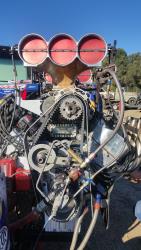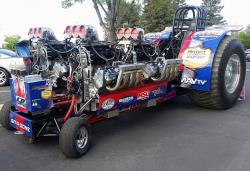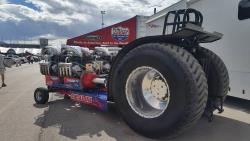Git R Done Tractor Pulling Team Explains the Challenges and Goals of Tractor Pulling
- 9 Dec 2016
Now imagine four of these monster motors hitched together with the sole purpose of dragging a sled weighing nearly a quarter of a ton about the length of the football field. Welcome to the world of competitive tractor pulling. The routes of tractor pulling go back to when farm implements were pulled by horses, and farmers would compete against one another to prove who had the most powerful animals. In some horse teams competed by pulling laden carts loads over a set distance. Eventually the competition evolved and horses would pull a weighted skid, with more weight added as competitors were eliminated. These events continue to this day with specially bred draft horses bred to have high strength for pulling heavy loads. While horses continue to pull, motorized tractor competition began in 1929 at events at sites like Bowling Green, Ohio, which continues to be the site of the NTPA National Championship. Not unlike short track dirt racing during the period into the 1960s rules varied from state to state, and even county to county. The lack of ability for a team to compete less than 50 miles from home severely limited the growth of the sport. Recognizing this limitation, representatives from eight states created a common set of rules and established the National Tractor Pullers Association (NTPA). In the early 1970s, most competitors used standard farm vehicles, with the motto, "Pull on Sunday, plow on Monday". There were two classes: stock tractors, which were commercially-available tractors as produced by manufacturer and modified tractors, which were basic tractor chassis powered by a virtually unlimited choice of engines.
Besides the multiple engine configurations that the Correia family runs, motors as diverse as Russian helicopter and torpedo boat engines, Continental AV1790 M103 tank engines, or an Allison V-1710 V-12 aircraft engine from a WW II P-38 or P-41. The father and son Git R Done team of Clarence and Jeremy Correia run their four-engine machine as two separate banks of V-8 engines, connected crank to crank. Power is then feed to an Engler Cross Box, whose function is to couple the left and right pairs of engines together. The goal of a Tractor Pull is to overcome the weight that the tractor is dragging, and in doing so pulling it farther than any of your competitors. The diabolical part is that the sled isn’t static weight - it contains a a heavy box filled that is mechanically winched forward as the sled progresses down the course. Pulling this ever-increasing load overcomes the power of the tractor and it stops short, although on occasion one will reach the end of the course, which is known as a “full pull.” The distance from start to finish is measured in thousandths of an inch and the tractor that pulls the sled the farthest distance is declared the winner. If more than one competitor reaches the full pull mark, a pull-off is held to determine a winner. Sort of like drag racing with each car connected to a powerful spring back at the start line. So what’s it like to make a run in a four-engine, 8000-lb., Unlimited Class tractor? Let’s have Jeremy walk us through it. “Since this isn’t a speed sport, you don’t need to jump on the gas. Instead you apply a light throttle for the first five to 10 feet and make sure your tires have sufficient grip.” Side note here. The tires are Firestone Puller 2000 and they’re designed especially for tractor pulls. Should you see one you’ll notice that they don’t have much of a tread as a farm tractor tire. This was done to reduce the amount of dirt thrown back against the skid, which would build up and add resistance. Back to Jeremy:
“Weight transfer is another important factor, and I know that I’ve balanced the tractor just right when the front wheels are one foot off the ground. Higher and too much weight is being transferred, down on the ground is not enough.” “In traveling the course of the run, even though my forward speed is only about 30 – 40 mph, the tires are spinning at 98 mph,” Jeremy added. “You put it all together like that and you’ve earned yourself a full pull.” If you’re a fan of motorsports you owe it to yourself to check out a Tractor Pull at least once. Where other forms of racing have limited the horsepower of cars or the length of the venue, this is still the Wild West, where if you have a better idea, build it and come take on the rest. | ||||
| | ||||
| ||||
| | ||||












